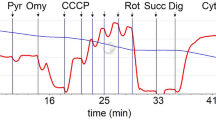Abstract
The endoplasmic reticulum (ER) resident—94 kDa glucose-regulated protein (GRP94), plays a pivotal role in cell death due to ER stress. In our study expression of GRP94 was increased in human neuroblastoma SH-SY5Y cells due to exposure to calcium ionophore A23187. A23187-mediated cell death was associated with activation of the major cysteine proteases, caspase-3 and calpain. Pretreatment with adenovirus-mediated antisense GRP94 (AdGRP94AS) reduced viability of SH-SY5Y cells subjected to A23187 treatment compared with wild type cells or cells with adenovirus-mediated overexpression of GRP94 (AdGRP94S). These results indicated that suppression of GRP94 is associated with accelerated cell death. Moreover, expression of GRP94 suppressed A23187-induced cell death and stabilized calcium homeostasis.
Similar content being viewed by others
References
Chang RCC, Suen KC, Ma CH, et al. Involvement of double-stranded RNA-dependent protein kinase and phosphorylation of eukaryotic initiation factor-2alpha in neuronal degeneration. J Neurochem 2002; 83: 1215–1225.
Yu ZF, Luo H, Fu W, Mattson MP. The endoplasmic reticulum stress-responsive protein GRP78 protects neurons against excitotoxicity and apoptosis: Suppression of oxidative stress and stabilization of calcium homeostasis. Exp Neurology 1999; 155: 302–314.
Reimertz C, Kogel D, Lankiewicz S, Poppe M, Prehn JHM. Ca2+-induced inhibition of apoptosis in human SH-SY5Y neuroblastoma cells: Degradation of apoptotic protease activating factor-1 (APAF-1). J Neurochem 2001; 78: 1256–1266.
MacGinnis KM, Gnegy ME, Park YH, Mukerjee N, Wang KKW. Procaspase-3 and poly (ADP) ribose polymerase (PARP) are calpain substrates. Biochem Biophys Res Comm 1999; 263: 94–99.
Nakagawa T, Yuan J. Cross-talk between two cysteine protease families. Activation of caspase-12 by calpain in apoptosis. J Cell Biol 2000; 150(4): 887–894.
Reddy RK, Lu J, Lee, AS. The endoplasmic reticulum chaper-one glycoprotein GRP94 with Ca(2+)-binding and antiapoptotic properties is a novel proteolytic target of calpain during etoposide-induced apoptosis. J Biol Chem 1999; 274: 28476–28483.
Bando Y, Katayama T, Kasai K, et al. GRP94 suppresses ischemic neuronal cell death against ischemia/reperfusion injury. Eur J Neurosci 2003; 18: 829–840.
Kubbutat MH, Vansden KH. Proteolytic cleavage of human p53 by calpain: A potential regulation of protein stability. Mol Cell Biol 1997; 17: 460–468.
Wood DE, Thomas A, Dev LA, et al. Bax cleavage is mediated by calpain during drug-induced apoptosis. Oncogene 1998; 17: 1069–1078.
Katayama T, Imaizumi K, Sato N, et al. Presenilin-1 mutations downregulate the signalling pathway of the unfolded-protein response. Nat Cell Biol 1999; 1: 479–485.
Bando Y, Ogawa S, Yamauchi A, et al. 150-kDa oxygen-regulated protein (ORP150) functions as a novel molecular chaperone in MDCK cells. Am J Physiol Cell Physiol 2000; 278: C1172–C1182.
Koch G, Smith M, Macer D, Webstar P, Mortara R. Endoplasmic reticulum contains a common, abundant calcium-binding glycoprotein, endoplasmin. J Cell Sci 1986; 86: 217–232.
Rapoport TA. Transport of proteins across the endoplasmic reticulum membrane. Science 1992; 258: 931–936.
Berridge MJ. Capacitative calcium entry. Biochem J 1995; 312: 1–11.
Lee AS. The glucose-regulated proteins: Stress induction and clinical applications. TRENDS in Biochem Sci 2001; 26: 504–510.
Booth C, Koch GLE. Perturbation of cellular calcium induces secretion of luminal ER proteins. Cell 1989; 59: 729–737.
Chen L, Gao X. Neuronal apoptosis induced by endoplasmic reticulum stress. Neurochem Res 2002; 27(9): 891–898.
Gregory JZ, Jin ML, Dennis WC. Reducing calcium overload in the ischemic brain. The New Eng J Med 1999; 341, 20: 1543–1544.
Vitadello M, Penzo D, Petronilli V, et al. Overexpression of the stress protein GRP94 reduces cardiomyocyte necrosis due to calcium overload and simulated ischemia. FASEB J 2003; 17: 923–925.
Miyazaki M, Ozawa K, Hori O, et al. Expression of 150-kd oxygen-regulated protein in the hippocampus suppresses delayed neuronal cell death. J Cereb Blood Flow Metab 2002; 22: 979–987.
Imai Y, Soda M, Takahashi R. Parkin suppresses unfolded protein stress-induced cell death through its E3 ubiquitin-protein ligase activity. J Biol Chem 2000; 275: 35661–35664.
Arnaudeau S, Frieden M, Nakamura K, et al. Calreticulin differentially modulates calcium uptake and release in the endoplasmic reticulum and mitochondria. J Biol Chem 2002; 277(48): 46696–46705.
Csermely P, Schnaider T, Soti C, Prohaszka Z, Nardai G. 90-kDa molecular chaperone family: Structure, function, and clinical applications.Acomprehensive review. Pharmacol Ther 1998; 79: 129–168.
Liu H, Miller E, van de Water B, Stevens JL. Endoplasmic reticulum stress proteins block oxidant-induced Ca2+ increases and cell death. J Biol Chem 1998; 273: 12858–12862.
Tamatani M, Matsuyama T, Yamaguchi A, et al. ORP150 protects against hypoxia/ischemia-induced neuronal death. Nat Med 2001; 7: 317–323.
Ohkubo N, Mitsuda N, Tamatani M, et al. Apolipoprotein E4 stimulates cAMP response element-binding protein transcriptional activity through the extracellular signal-regulated kinase pathway. J Biol Chem 2001; 276: 3046–3053.
Kanegae Y, Miyake S, Sato Y, Lee G, Saito I. Adenovirus vector technology: An efficient method for constructing recombinant adenovirus and on/off switching of gene expression. Acta Paediatrica Japonica 1996; 38: 182–188.
Altznauer F, Simon HU. Calpain is a major regulator of neurotrophils apoptosis. Scientific World Journal 2001; 1(S3): 91.
Wood DE, Newcomb EW. Caspase-dependent activation of calpain during drug-induced apoptosis. J Biol Chem 1999; 274: 8309–8315.
Choi DW. Calcium and excitotoxic neuronal injury. Ann NY Acad Sci 1994; 747: 162–171.
Author information
Authors and Affiliations
Corresponding author
Rights and permissions
About this article
Cite this article
Bando, Y., Katayama, T., Aleshin, A.N. et al. GRP94 reduces cell death in SH-SY5Y cells perturbated calcium homeostasis. Apoptosis 9, 501–508 (2004). https://doi.org/10.1023/B:APPT.0000031446.95532.ad
Issue Date:
DOI: https://doi.org/10.1023/B:APPT.0000031446.95532.ad




